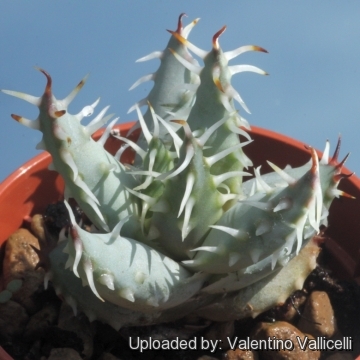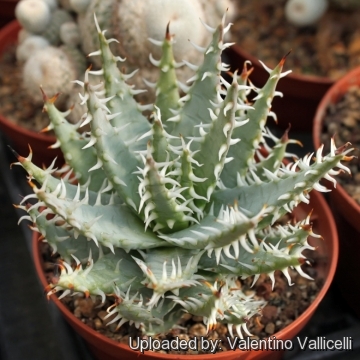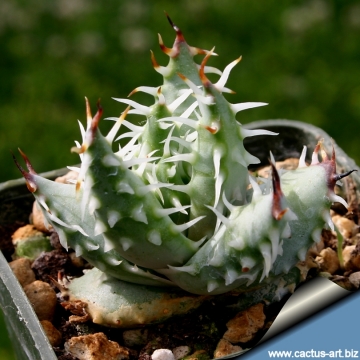
Aloe melanacantha var. erinacea Photo by: Viviana Alejandra Castro
Origin and Habitat: Namibia (Lüderitz district and southwards to Witputs)
Habitat: Grows in very arid areas in rocky and sandy soils on the northern hills and mountains at 900 - 1350 m. in altitude.
Ecology: Aloe erinaceaSN|618]]SN|618]] produces nectar, and is therefore pollinated by sugar birds as well as winged and crawling insects such as ants which are small enough to enter the flower tube in which the nectar is stored. After fertilization, the fruit, which is called a capsule, grows quickly and splits into three parts in spring and summer. The seeds are small, up to 4 mm and slightly winged, enabling it to be dispersed by the wind. The plant in itself is very tough, and can often survive for several seasons without water, at which point the leaves turn reddish, a sign generally associated with stress.
Synonyms:
See all synonyms of Aloe melanacantha
back
Accepted name in llifle Database:Aloe melanacantha var. erinacea (D.S.Hardy) G.D.RowleyExcelsa 9: 71, 80, (1980)Synonymy: 2
Accepted name in llifle Database:Aloe melanacantha A.BergerBot. Jahrb. Syst. 36(1): 63. 1905 [28 Feb 1905]
back
Description: Only recently discovered (botanically, that is) in the mid 1980's in Namibia, it seems strange that such an impressive plant could have remained unknown for so long. It is a winter-growing species, related and very similar to Aloe melanacanthaSN|12205]]SN|12205]] but it can be distinguished from the latter by its open rosettes of spreading leaves and shorter flowers. The plant is compact and almost never offsets (in cultivation), but in habitat it occurs in clusters of up to10 (or more) decumbent stems up to 50 cm tall, covered with old leaves bases.
Stem: Stemless even in old specimens, or short-stemmed.
Leaves: Pale grayish-green, blue-grey or brownish green (in full sun), narrow, deltoid lanceolate, biconvex, keeled, leaves are curved inwards, which gives the plant its rounded shape. About 8-16 long x 3-4 cm wide, and armed with sharp white or black spines, arranged singularly along the keel and margins. They are not tender, but firm and can scrape you. Spines are up to10 mm long, and are glossy white in the younger leaves. The thorns at the leaf bases may be shorter and whitish.
Inflorescence: Simple, densely flowered.
Flowers: Red, turning yellow, tubular in shape and droop ± 28 mm.
Blooming season: Summer, but this species it is reluctant to bloom, and for a seedling the first bloom would not be expected until the 25th year from sowing (or more)
Seed: As with other aloes, the seeds are typically winged, small, up to 3 mm and produced in abundance inside the fruit capsules that split into three when ripe. Seeds ripen normally around August–September.
Subspecies, varieties, forms and cultivars of plants belonging to the Aloe melanacantha group
- Aloe melanacantha A.Berger
 Aloe melanacantha var. erinacea (D.S.Hardy) G.D.Rowley: has open rosettes of spreading leaves and shorter flowers.Leaves blue-grey armed with sharp white or black spines, arranged singularly along the keel and margins. Distribution: Namibia (Lüderitz to Witputs)
Aloe melanacantha var. erinacea (D.S.Hardy) G.D.Rowley: has open rosettes of spreading leaves and shorter flowers.Leaves blue-grey armed with sharp white or black spines, arranged singularly along the keel and margins. Distribution: Namibia (Lüderitz to Witputs)
Bibliography: Major references and further lectures
1) Diana Morgan “Succulents for Mediterranean Climate Gardens” Rosenberg Publishing Pty, Limited, 2004
2) Urs Eggli “Illustrated Handbook of Succulent Plants: Monocotyledons” Springer, 2001
3) Hans Bornman, David S. Hardy “Aloes of the South African veld” Voortrekkerpers, 1971
4) “SWA Annual: SWA Jaarboek. SWA Jahrbuch” South West Africa Publications, Limited, 1985
5) Gilbert Westacott Reynolds “The aloes of South Africa” A.A. Balkema, 1974
 Aloe melanacantha var. erinacea Photo by: Valentino Vallicelli
Aloe melanacantha var. erinacea Photo by: Valentino Vallicelli Aloe melanacantha var. erinacea Photo by: Raimondo Paladini
Aloe melanacantha var. erinacea Photo by: Raimondo Paladini Aloe melanacantha var. erinacea Photo by: Valentino Vallicelli
Aloe melanacantha var. erinacea Photo by: Valentino Vallicelli - (A juvenile specimen) This is a very rare white-spined, somewhat dwarf version of A melanocantha, and is not easily mistaken for another Aloe specie. It's a true gem. Photo by: Cactus Art
- (A juvenile specimen) This is a very rare white-spined, somewhat dwarf version of A melanocantha, and is not easily mistaken for another Aloe specie. It's a true gem. Photo by: Cactus ArtCultivation and Propagation: Aloe erinaceaSN|618]]SN|618]] is one of the slowest growing specie and quite difficult to care for, well out of habitat. It is also very slow to flower, and it's even rare in its native land for it to flower. In cultivation the plant seems to remain exactly the same size for years. It's fairly cold tolerant, for an aloe. It does well planted in the ground, but it is rarely grown outdoors since large plants are costly, and it makes such a good potted specimen. This plant does well in direct sun. Light fertilizer seems to boost its growth whenever additional water is given. Watering: Careful watering
Propagation: Propagation is by seed, as it seldom offsets. Seeds must be sown as fresh as possible. When kept too long they are parasitized by small crawling insects. The best time for sowing would be in the summer from October to December. Use coarse river sand and cover seeds lightly, then keep moist. It is advisable to treat seeds with a long-lasting fungicide, as seedlings are prone to damping off, a fungus that eventually kills the young plants. If you have a number of them you could intentionally damage the growing point to see if it will offset, but wait to do that until September or so, when its growing season is beginning.














